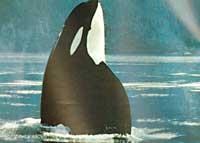The whales separate
1992/09/01 Otaolaurretxi, Jon Iturria: Elhuyar aldizkaria
Exploring the ocean waters
Americans delay a research project that could have very negative ecological effects. It was intended to create sound sounds in the oceans to measure the greenhouse effect of our planet. (The greenhouse effect, as is known, is the warming of the environment by passing the light waves reflected on the earth in our atmosphere by CO 2, CH 4 and other gases, preventing infrared waves from coming out). When the atmosphere is heated by greenhouse effect, a piece of heat passes into the oceans because air and water are in continuous contact.
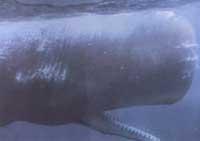
The study of sound transmission in marine waters allows to measure changes. The sound waves are transmitted faster in hot water than cold. According to Scripps Institution of Oceanography scientist Walter Munk, if the oceans warm up the sound waves will take between 0.1 and 0.2 seconds to travel the 15,000 km.
For this reason, it proposes to measure the transmission time in recorders away from the sound source in the water. To measure the transmission at distances of up to 18,000 km, researcher Munk proposes to place five speakers on Heard Island of the Indian Ocean in the vicinity of Antarctica. Hence the sound waves would extend to the Indian Ocean, the Pacific and the Atlantic Ocean, taking three and a half hours to reach San Francisco or Bermuda.
The speakers would emit a sound of 209 decibels (intensity that is the one that takes a big jet reactor and that can kill the person) for an hour, with a silence of another hour. The essay would last ten days.
When the request for authorization is moved to the National Oceanic and Atmospheric Administration (NOAA), an intense debate has emerged about the presence of whales, seals, walruses and other animals that would die and be damaged. This type of trials have not yet been conducted and there is no precise record of the sound intensity that marine mammals can withstand. Nor is it clear how the intensity is cushioned in the water depending on the distance. There are those who say that the sound of 209 dB would go down to 120 dB to 50 km away, but there are those who say a distance of 800 km is needed. However, there have been intensities of 124 dB to 1000 km of the sound transmitter. Munk's trial is estimated to damage 200,000 cetaceans and 100,000 pinions.
The essay would generate two obstacles to marine mammals, since on the one hand they are oriented with a kind of sonar and on the other they communicate with each other through sounds. Whales, for example, send messages from a distance to each other, emitting modulated sounds in the form of songs.

For researchers William Watkins and Peter Tyac there is no doubt. Munk's test would alter the eating habits and communications of marine mammals in thousands of square kilometers. In the worst case, he would even kill the sound waves.
Disembarks in the Canary Islands
In this sense, the magazine “Science” has published another interesting news. L. L. Professor at the University of Las Palmas de Canarias. F. F. Veterinarios López Jurado and Mª of the Faculty of Biology of the University of London. P. P. Professor Simmonds has presented an interesting opinion on the landing of whale banks. According to them, military ships are responsible for the whales landing on the other beach. In October 1989, 24 whales of three different species died on the coast of Fuerteventura, when the navy operated there. Most were Cuvier whales (Ziphius cavirostris), although these whales hardly approach the beach.
These researchers have found disturbing and clarifying data. In 1985, 12 whales of different species landed on the same island, while the Navy carried out its maneuvers. In 1986 four other whales died on the same island (3 of the species Ziphius) and, in addition, two other katxalote pigmeo ( Kogia breviceps ) on the island of Lanzarote during military maneuvers.
These researchers have also analyzed the landing of other whales around the world. In Venezuela, for example, there was an underwater explosion in military maneuvers. Also in Corsica. They were provoked by the person, because three Ziphius whales and a dolphin appeared stuffed with bullets.
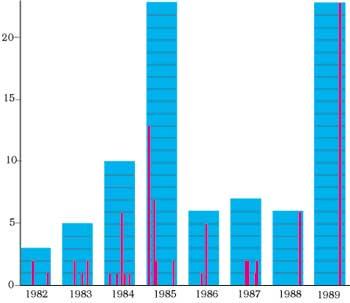
Cetacean detection system
However, little is known about the biology of cetaceans and it can happen that these marine mammals escape to the coast when ships enter their midst.
According to Anne Collet, a marine mammal explorer from La Rochelle (France), when boats or anything else emit sound waves, interferences occur in the cetacean detection system. Cetacean banks move to the coast due to interference in the guidance system.
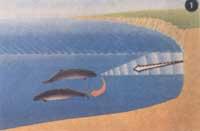

We know how the dolphin guidance and detection system works. It emits waves of 40 to 170 kHz vibrating the membrane of the three pairs of sacks it has at one end of the airway. These ultrasounds are constantly sent and their echo is collected by the lower marriage, transmitting their echo to the inner ear with a very fine fat containing. Finally, the auditory nerve carries information to the brain.
If the dolphin has issued a high-wavelength ultrasound, it will receive a blurred image of the topography around it, but it only needs to be oriented. However, when looking for food it emits a high-frequency sound or short wavelength and has a clear picture of each of the fish banks. The minimum detectable dimension is proportional to the wavelength it emits. With the dolphins many trials have been conducted and it has been concluded that they can differentiate very similar lead balls. They also separate the same diameter and different material.
The sound image obtained by the dolphin, even though it is a dozen times tougher than that of doctors on ultrasound, the whales commit suicide in groups all over the world. Therefore, interferences are considered to occur in your ultrasound network.
Another data favorable to this hypothesis. When they reach the beach to die the whale bank, they have endeavoured to leave accompanied by one of the teams, but soon returns with haste to the beach next to their companions. However, scientists realize that people have always sought to have the smallest, the youngest, cetaceans.
The Balenumes, therefore, followed the calls of their mother. And it is that young people do not dominate the sonar well until a long time with their mother. The child learns his mother's reactions when he receives the echo of the sonar, since not all echoes have the same meaning. An echo can correspond to the dam of interest and another to the rock. But how to interpret it, the sound of diving or the explosion?
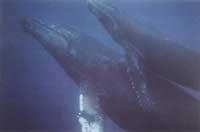
Another hypothesis that can explain the death of whales is interference in the ultrasound detection system. These events occur on many occasions on low-slope beaches. The echo of the ultrasound emitted in these cases is of very low quality and intensity. Therefore, if the ear of marine mammals does not receive it, it can reach death by landing on the sand.
However, Munk's project will be reviewed by NOAA, but many say it should be the responsibility of some international organization. And it is that the whales, oceans and other marine mammals that can be damaged are all.

Gai honi buruzko eduki gehiago
Elhuyarrek garatutako teknologia




